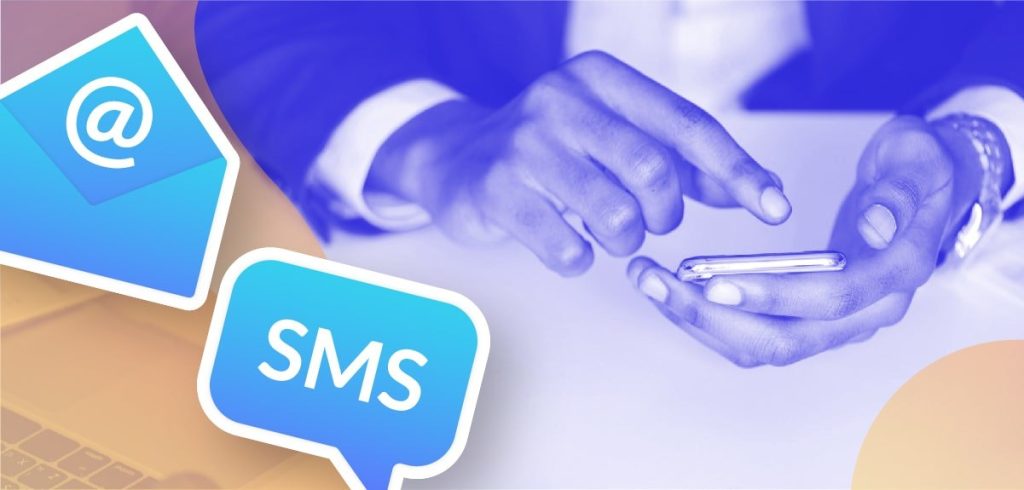SMS & Email Marketing
Precision Marketing: SMS and Email Strategies That Deliver Results!

What is SMS & Email Marketing?
SMS and email marketing are powerful tools that allow companies to connect directly with customers, delivering timely and relevant messages right to their phones and inboxes. SMS marketing leverages text messaging for instant communication, boasting impressive open rates and quick response times, making it ideal for promotions and urgent updates. On the other hand, email marketing provides a more detailed platform for storytelling and sharing valuable content, allowing businesses to build relationships through personalized communication. Together, these channels create a comprehensive marketing strategy that not only enhances customer engagement but also drives conversions.
Immediate Reach
Higher Conversion Rates
Direct Engagement
Case Study
Watch a brief video which further explains SMS & Email marketing:
FAQ
Frequently Asked Questions
1. Direct Communication
Both channels allow you to reach your customers directly, ensuring your message is seen. SMS messages have high open rates, often over 90%, while email allows for detailed information sharing.
2. Customer Engagement
These marketing methods foster stronger relationships with your audience. Regular communication through personalized messages keeps your brand top-of-mind and encourages customer loyalty.
3. Timeliness
SMS is ideal for time-sensitive promotions or alerts, while email can be used for detailed updates and newsletters. This combination ensures you can communicate effectively based on the urgency of your message.
4. Cost-Effective
Both SMS and email marketing are relatively low-cost compared to traditional advertising methods. They offer a high return on investment (ROI), making them accessible for businesses of all sizes.
5. Measurable Results
You can easily track the performance of your campaigns through metrics like open rates, click-through rates, and conversion rates. This data helps refine your strategies for better results.
6. Segmentation and Personalization
Both channels allow for targeted messaging. You can segment your audience based on their behavior and preferences, ensuring that your messages resonate with each recipient.
7. Brand Awareness
Regular interactions through SMS and email help increase brand visibility, keeping your business fresh in the minds of your customers.
Incorporating SMS and email marketing into your strategy enables you to create a robust communication plan that drives engagement, builds loyalty, and ultimately increases sales.
Segmenting an audience for SMS and email marketing involves dividing your subscriber base into specific groups based on various criteria. This allows for more targeted and personalized messaging, leading to higher engagement and conversion rates. Here’s how we do it:
1. Demographics
- Criteria: Age, gender, location, income level, etc.
- Benefit: Tailor messages based on demographic factors, ensuring relevance (e.g., promoting products popular among a specific age group).
2. Behavioral Data
- Criteria: Purchase history, website interactions, email engagement (opens, clicks).
- Benefit: Target messages based on previous interactions, such as sending follow-up offers to customers who abandoned their carts.
3. Preferences and Interests
- Criteria: Preferences indicated during sign-up or through surveys.
- Benefit: Create personalized content that aligns with individual interests, improving open rates and engagement.
4. Engagement Levels
- Criteria: Frequency of interaction with previous campaigns (active vs. inactive subscribers).
- Benefit: Tailor strategies for re-engaging inactive subscribers while nurturing relationships with highly engaged ones.
5. Geographic Segmentation
- Criteria: Location-based data (city, region, country).
- Benefit: Send localized promotions or event invitations that resonate with customers in specific areas.
6. Lifecycle Stage
- Criteria: Position in the customer journey (new subscribers, loyal customers, or lapsed customers).
- Benefit: Deliver targeted messages that align with their stage, such as welcome messages for new subscribers or win-back campaigns for lapsed customers.
Implementation
By using these segmentation strategies, we craft highly relevant and personalized messages that speak directly to the needs and interests of each group. This targeted approach not only improves engagement rates but also enhances the overall effectiveness of SMS and email marketing campaigns.
Tailoring SMS and email strategies to fit your specific business needs involves a structured and personalized approach. Here’s how we do it:
1. Understanding Your Objectives
- Initial Consultation: We begin with a detailed discussion to identify your marketing goals, whether it’s increasing sales, boosting engagement, or improving customer retention.
- Goal Alignment: We ensure that our strategies align with your overall business objectives and any specific campaigns you have in mind.
2. Audience Analysis
- Segmentation: We analyze your customer base to segment audiences based on demographics, behavior, and preferences. This allows for targeted messaging that resonates with each group.
- Persona Development: Creating detailed customer personas helps us understand their motivations and pain points, enabling us to craft relevant content.
3. Customized Content Creation
- Personalized Messaging: We develop SMS and email content that speaks directly to your audience’s interests, using their names and tailored offers to enhance engagement.
- Content Variety: Depending on your needs, we create a mix of promotional messages, informative content, and personalized updates to keep your audience engaged.
4. Timing and Frequency Strategy
- Optimal Timing: We analyze engagement data to determine the best times to send messages for maximum impact, ensuring your communications are received when your audience is most responsive.
- Frequency Planning: We establish a sending schedule that maintains consistent engagement without overwhelming your subscribers.
5. Testing and Optimization
- A/B Testing: We conduct tests on different message variations, subject lines, and sending times to identify what works best for your audience.
- Performance Monitoring: We continuously track metrics such as open rates, click-through rates, and conversion rates, using this data to refine our strategies.
6. Feedback and Adaptation
- Customer Insights: We encourage feedback from your subscribers, using surveys or engagement data to understand their preferences better.
- Agility in Strategy: Based on performance insights and customer feedback, we adjust our strategies to ensure they remain effective and aligned with your goals.
7. Regular Communication and Reporting
- Transparent Updates: We keep you informed with regular reports on campaign performance and insights, fostering a collaborative approach to strategy refinement.
- Strategic Meetings: Periodic check-ins help us discuss results, gather your input, and adjust our tactics as necessary.
By following this tailored approach, we ensure that our SMS and email marketing strategies effectively meet your unique business needs and drive desired outcomes.
Integrating SMS and email marketing with your existing marketing efforts involves a strategic approach to ensure all channels work harmoniously. Here’s how we do it:
1. Comprehensive Assessment
- Review Current Strategies: We start by evaluating your existing marketing channels, such as social media, content marketing, and paid advertising, to identify areas for integration.
- Goal Alignment: We ensure that SMS and email strategies align with your overall marketing goals, maintaining a consistent brand message across all platforms.
2. Unified Messaging
- Consistent Branding: We develop messaging that reflects your brand voice and identity across SMS, email, and other channels, ensuring a cohesive experience for your audience.
- Cross-Promotion: We create opportunities to promote your SMS and email campaigns through your other marketing channels, encouraging sign-ups and engagement.
3. Customer Journey Mapping
- Integrated Customer Experience: We map out the customer journey to identify touchpoints where SMS and email can enhance interactions, providing timely and relevant communications.
- Lifecycle Campaigns: We develop lifecycle marketing strategies that use both channels to nurture leads and engage customers at various stages of their journey.
4. Data Synchronization
- Shared Data Insights: We integrate data from all channels to gain a holistic view of customer behavior, preferences, and interactions, allowing for more personalized messaging.
- Segmentation Across Channels: We use insights from SMS and email engagement to inform other marketing efforts, ensuring targeted messaging across all platforms.
5. Automation and Workflows
- Automated Campaigns: We set up automated workflows that trigger SMS and email messages based on customer actions, such as sign-ups, purchases, or abandoned carts, to streamline communication.
- Coordinated Scheduling: We plan the timing of SMS and email campaigns to complement each other, ensuring customers receive consistent messaging without overlap.
6. Performance Monitoring
- Integrated Analytics: We track and analyze performance metrics for SMS and email campaigns alongside other marketing efforts to assess overall effectiveness and ROI.
- Adjusting Strategies: We use insights from these analytics to refine strategies across all channels, ensuring continuous improvement.
7. Feedback Loops
- Gathering Insights: We encourage feedback from your audience through SMS and email, using their responses to enhance the overall marketing strategy.
- Regular Review Meetings: We hold periodic meetings to review performance across all channels, discussing insights and adjustments to maintain alignment.
By following these steps, we ensure that SMS and email marketing not only enhance your existing marketing efforts but also create a seamless and engaging experience for your customers.
Optimizing campaigns after launch is crucial for maximizing effectiveness and achieving desired outcomes. Here’s our comprehensive process for campaign optimization:
1. Performance Monitoring
- Real-Time Tracking: We use analytics tools to monitor key performance metrics, such as open rates, click-through rates, conversion rates, and unsubscribe rates, in real time.
- Data Collection: We gather data continuously throughout the campaign to identify trends and patterns.
2. A/B Testing
- Experimentation: We conduct A/B tests on various elements of the campaigns, such as subject lines, content formats, sending times, and call-to-action (CTA) buttons.
- Analysis of Results: We compare the performance of different versions to determine which variations resonate best with the audience.
3. Audience Feedback
- Surveys and Polls: We incorporate customer feedback mechanisms, such as surveys or polls, to gather insights directly from your audience about their preferences and experiences.
- Engagement Analysis: We analyze customer interactions with the campaign to understand what worked well and what didn’t.
4. Segmentation Refinement
- Review Segmentation Criteria: We evaluate the effectiveness of audience segments used in the campaign and adjust them based on engagement data.
- Personalization Enhancement: We refine personalization strategies to improve relevance and connection with different audience segments.
5. Content Evaluation
- Content Performance Review: We analyze which messages and content types generated the most engagement and conversions.
- Iterative Improvements: Based on this analysis, we make necessary adjustments to content for future campaigns to enhance clarity, relevance, and appeal.
6. Timing and Frequency Adjustment
- Optimal Timing Analysis: We review the performance based on when messages were sent to identify the best times for future communications.
- Frequency Optimization: We adjust the frequency of messages to avoid subscriber fatigue while maintaining engagement.
7. Reporting and Insights
- Detailed Reporting: We provide comprehensive reports that summarize campaign performance, insights, and areas for improvement.
- Actionable Recommendations: Along with the reports, we offer clear recommendations for future campaigns based on the data collected.
8. Ongoing Strategy Refinement
- Regular Review Meetings: We hold post-campaign reviews to discuss performance, insights, and strategic adjustments moving forward.
- Continuous Learning: We stay informed about industry trends and best practices, integrating new strategies into future campaigns.
By implementing this structured optimization process, we ensure that each campaign is continually refined and improved, maximizing engagement and driving better results over time.
